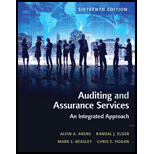
a.
Compute the appropriate non-statistical
b.
Ascertain the initial sample sizerequired to satisfy therequirements of auditor using attributes sampling.
c.
Explain the effect on the initial sample size (increase or decrease) of changingeach of the following factors keeping other factors same.
d.
Explain the large differences occurred in the sample sizes for columns 3 or 6.
e.
Explain the differences in the results of Requirement C with the results obtained in Requirement A or Requirement B. Identify the four factors appears to havethe greatest effect and the least effect on the initial sample size.
f.
Explain the reasons for sample size and initial sample size being the similar term.
Want to see the full answer?
Check out a sample textbook solution
Chapter 15 Solutions
Auditing and Assurance Services, Student Value Edition (16th Edition)
- Compute the meterialsarrow_forwardSkyline Enterprises' CVP income statement includes sales of 5,500 units, a selling price of $120 per unit, variable expenses of $75 per unit, and fixed expenses of $140,000. What is the net income? a. $82,500 b. $125,000 c. $107,500 d. $75,000arrow_forwardFinancial Accountingarrow_forward
- Don't use ai given answer accounting questionsarrow_forwardDuring 20x2 Creswell Corporation sold $5,500 of inventory on credit. The company's beginning and ending accounts receivable balances were $30,000 and $32,500, respectively. How much cash did Creswell Corporation collect on the account? If the ending accounts receivable had been $27,000, how much cash would Creswell Corporation have collected?arrow_forwardHow much cash was collected from customers during 2023 on these general accounting question?arrow_forward
 Auditing: A Risk Based-Approach (MindTap Course L...AccountingISBN:9781337619455Author:Karla M Johnstone, Audrey A. Gramling, Larry E. RittenbergPublisher:Cengage Learning
Auditing: A Risk Based-Approach (MindTap Course L...AccountingISBN:9781337619455Author:Karla M Johnstone, Audrey A. Gramling, Larry E. RittenbergPublisher:Cengage Learning Essentials of Business Analytics (MindTap Course ...StatisticsISBN:9781305627734Author:Jeffrey D. Camm, James J. Cochran, Michael J. Fry, Jeffrey W. Ohlmann, David R. AndersonPublisher:Cengage Learning
Essentials of Business Analytics (MindTap Course ...StatisticsISBN:9781305627734Author:Jeffrey D. Camm, James J. Cochran, Michael J. Fry, Jeffrey W. Ohlmann, David R. AndersonPublisher:Cengage Learning

